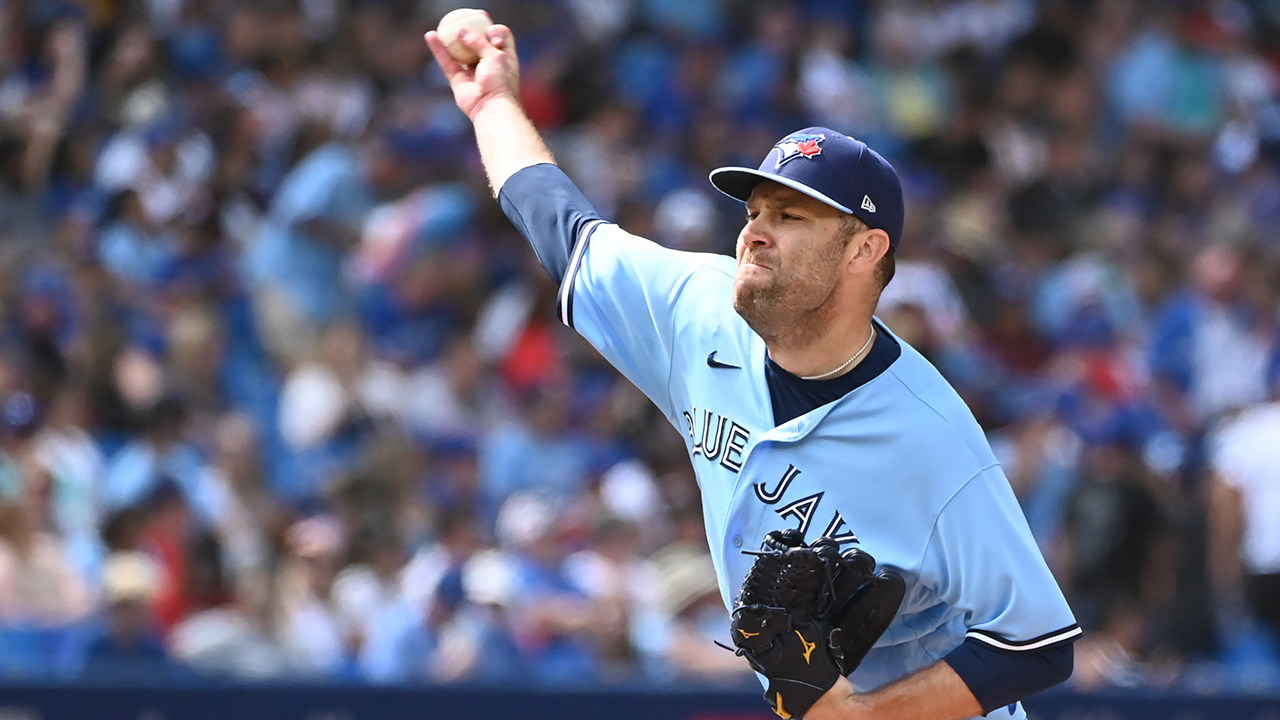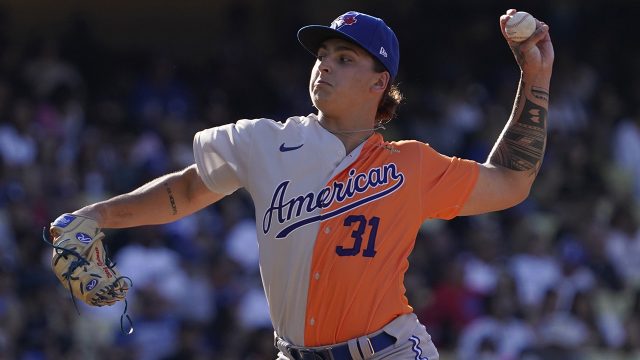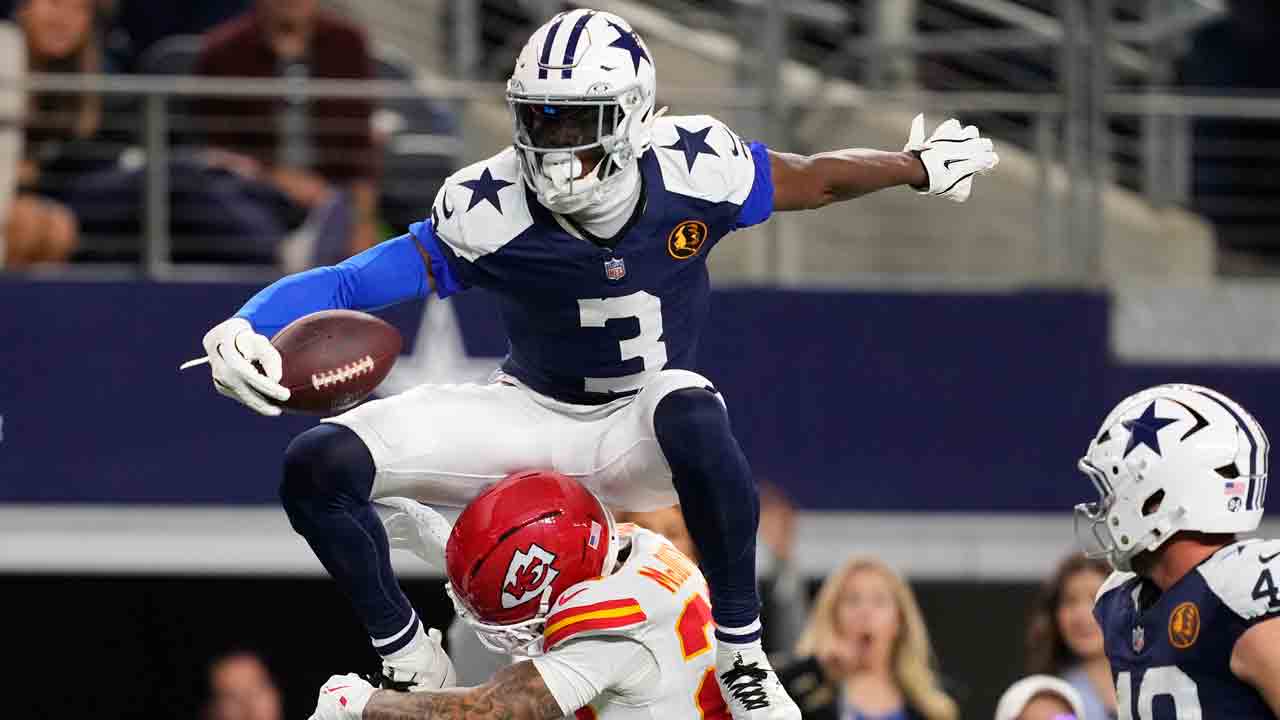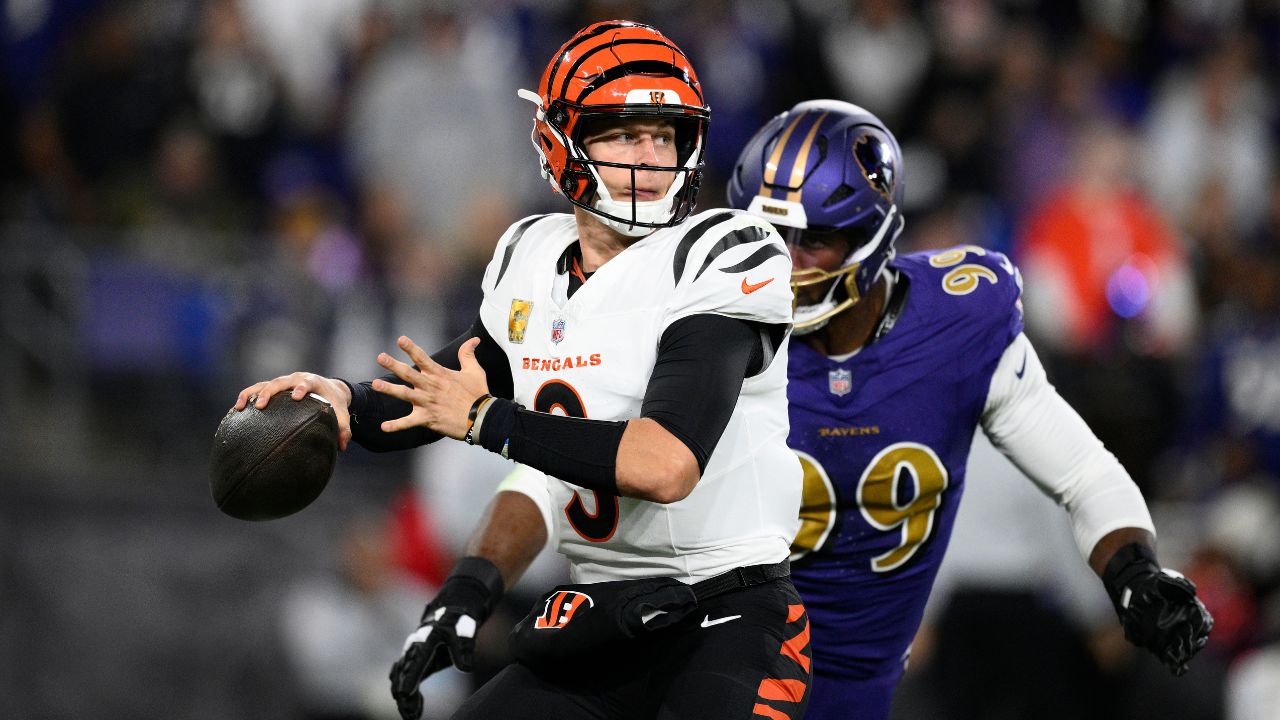
TORONTO — When David Phelps went to the playoffs as a rookie in 2012 with the New York Yankees, he assumed every season of his career was going to end that way. Why wouldn’t it? He was only 25 — the youngest player on that 95-win team’s active roster. He didn’t know any better.
This October, 10 years, seven organizations, four kids, three surgeries, and a metric ton of perspective later, a 36-year-old Phelps finally returned to the postseason with the Toronto Blue Jays. The oldest player on that 92-win team’s active roster, he knew exactly what an accomplishment it was.
That’s why Phelps took a second, amidst the bedlam of a post-clinching Blue Jays clubhouse, with teammates yelling, dancing and spraying champagne around him, to let it sink in. He thought about how special and rare those moments were. About how many cities, teammates, coaches, and staff he’d come to know over the decade in between. About how little he really understood the game he loved when he was 25.
And then he walked into Blue Jays manager John Schneider’s office.
“I guess that’s when it became official. I looked at him, shook his hand, and said, ‘You’re the last manager I ever played for,’” Phelps remembers. “He gave me a big hug and we just sat and chatted for a while. That was the first time I actually said out loud that I was retiring. It was kind of cool to do it in that moment when we were on such a high, to say it to someone that I incredibly respect, around a group of people that I genuinely care for. It was really cool.”
It may appear strange to see Phelps, the 10-season MLB veteran who officially retired this week, walking away at a time he’s still reliably getting big-leaguers out. He just posted a 2.83 ERA with a strikeout per inning over a healthy, 65-appearance campaign. He produced well above average quality-of-contact metrics, allowing only two home runs all year. There were opportunities for him to continue pitching at the highest level in 2023 if he wanted them. But Phelps knew last season was going to be his last for some time.
He’d seen where the game was going for years — away from control artists like him who work to the corners for called strikes and towards overpowering arms who blow wipeout stuff past hitters’ bats. He’d felt how much harder it was getting, as he crept deeper into his mid-30’s, to execute his cutter on the edges, to spin his curveball at the bottom of the zone, to peel himself off the trainer’s table every gameday afternoon to go out and play catch.
He’d poured everything he had into professional pitching for 15 years, the first few as a promising young starter with spectacular minor-league numbers and the last few as a nomadic MLB middle reliever, one of the game’s most thankless, uncertain, under-compensated roles. He couldn’t imagine, after twice returning from major surgeries that required year-long rehabs, what confronting another injury would feel like; what it would even mean to begin another throwing progression six weeks after the end of the season.
“I’m incredibly grateful for the opportunity I had this year and also for the season that I was able to have,” Phelps says. “But it wasn’t easy.”
Phelps has always loved baseball’s relentless daily grind. Weights, mobility, soft tissue work, arm care, bullpens, everything. He had his routine down to a science. Trainers could predict to the minute when Phelps would be arriving for pre-game work. Teammates knew exactly when to find him doing a daily crossword at his locker. Staff encountered him at the same time in the hot and cold recovery tubs long after each game, Hamilton’s “One Last Time” reverberating from speakers beside him.
But it only gets harder. The more miles you put on the odometer, the more work you have to do under the hood. There’s a reason there were only 30 pitchers over the age of 35 to appear in an MLB game last season. Each summer, around 350 pitchers are selected in the MLB draft; each winter, scores more are signed internationally. Few make it this far.
Phelps never begrudged the volume of work he had to put in to make those career-high 65 appearances last season — but he knew early on that if he had the year he wanted to, he’d be content with walking away. The low 2.00’s ERA he carried through mid-June served only to reinforce those thoughts, not to tempt him to come back in 2023 for another go. He wanted to leave on a high — in more ways than one.
“I got through the season healthy, my team made the playoffs — and I couldn’t have asked for a better group of guys to do it with. The relationships that I have on that team, it felt like a family,” Phelps says. “So, it felt like the right time. I’ll always love this game. That will never be in question. But the last time I walked off the field, I was at peace with it. I’m at peace with it to this day.”
Selected in the 14th round of the 2008 draft by the Yankees, Phelps made his MLB debut in 2012 in a swing role, one he served in through the first five seasons of his career. He converted to full-time relief in 2017, a campaign that saw him split time between the Miami Marlins and Seattle Mariners. The subsequent spring, as he was ramping up for his final year prior to reaching free agency, Phelps tore the ulnar collateral ligament in his right elbow and underwent Tommy John surgery.
Early in 2019, Phelps signed an incentive-laden deal with the retooling Blue Jays and returned to an MLB mound for the first time in 21 months. Toronto traded him to the Chicago Cubs at that year’s deadline, and after spending pandemic-shortened 2020 with the Milwaukee Brewers and Philadelphia Phillies, Phelps returned to the Blue Jays in 2021 on a one-year deal.
But that May, carrying a 0.87 ERA through his first 11 appearances of the season, Phelps tore his right latissimus dorsi from his humerus while warming up to enter a game — a freak injury that required a rare revision procedure to reattach muscle to bone. With a host of specialists presenting him slim odds of ever throwing a baseball as hard or as accurately as he had in the past, Phelps strongly contemplated retirement at the time, but ultimately decided to fight through a nine-month rehab and look for one last opportunity to go out on a better note in 2022.
The Blue Jays gave it to him with a minor-league deal and, after winning a job in the club’s bullpen out of spring training, Phelps went on to finish second on the club in appearances and tied for the 11th-most across MLB. It took an incredible off-field effort to remain healthy from start to finish under such a high workload — to say nothing of Phelps’ excellent on-field results.
“Doing that at 35, going on 36, coming off a major shoulder surgery — that’s pretty uncommon. Even the treatment I was getting during the season was unique for some of our staff,” Phelps says. “The training staff in Toronto did an incredible job. Every single one of them played a role in it. For the first time in my career, I went opening day to the last game of the season fully healthy and not on the IL. That was really big for me.”
Phelps started Toronto’s final game of the season in Baltimore as a tune-up outing prior to the playoffs, retiring the side on 14 pitches. For a pitcher who’d begun his professional journey as a starter, and might have stuck as one if not for injuries and circumstances beyond his control, there was something poetic about walking off a big-league mound for the final time after a start.
“It was a full circle moment for me. I’ve had some of my worst career games in Baltimore as a starter,” Phelps says. “Getting that start, I had so many emotions. My family was there. And then after throwing my inning, getting to relax, go out in the dugout and take in the rest of the game, was really cool. I felt like there was a clock going, and every out that passed was one out closer to my final regular season being done and my career coming to an end.”
Phelps found a lot of moments like that to take things in for the final time throughout the latter half of the season. As the Blue Jays made their last visits to venerated ballparks like Yankee Stadium and Fenway Park, Phelps went on walks throughout the stadium and regularly spent a solitary, post-game moment with himself in the dugout on getaway day.
After the Blue Jays were eliminated from the playoffs in a wild card series at Rogers Centre, as everyone was changed, packed up, and saying their goodbyes, Phelps was still in his jersey because he didn’t want to take it off. Hours after the game, he wandered out to the bullpen and spent time there by himself. He sat for a while in the Blue Jays dugout. He thought about the all-consuming baseball life he was leaving behind.
“There’s such a beauty in the monotony of baseball when you’re going through it. I loved knowing that I was going to get to the field and my routine was going to be my routine. That I was going to use that to manage 162 games in 183 days,” Phelps says. “Part of what kept me going was that I loved that grind so much. In-season, off-season — I always loved to work. Essentially because I had to. I played professionally for 15 years and for the first eight, I threw 88-92. So, I had to figure out what I did well. And I had to find a way to tap into more velocity. I was fortunate to work with a lot of people who helped me do that.”
Phelps finishes his career with a 3.80 ERA over 682.2 innings pitched. He appeared in 10 separate MLB seasons, making 67 starts and 300 relief appearances. His pitch mix ran five offerings deep at times, but it was his control and command of a trio of fastballs — a four-seamer, two-seamer, and cutter — that formed the foundation of his success.
After converting to a full-time relief role, Phelps’ four-seamer sat in the mid-90’s prior to Tommy John surgery and was still touching 95 last season following his lat revision. His cutter was softer but moved vertically over four inches more than the average MLB one, which is why opponents produced only a 16.3 per cent hard-hit rate against it in 2022.
Meanwhile, Phelps allowed only two extra-base hits off his sinker over the final four seasons of his career. He relied more heavily on his curveball in recent years, earning a 22.5 per cent whiff rate with the pitch in 2022. And he had a sneaky changeup he threw just often enough to keep in the minds of left-handed hitters.
Put it all together and Phelps had a variety of paths to attack either side of the platoon. The Blue Jays leveraged that by often deploying him as a fireman in 2022, summoning Phelps into middle-inning spots where his mettle, strike-throwing, and soft contact-generating repertoire helped him navigate the jams fatigued starters left behind.
It was an unglamorous, oft-overlooked role. But are the Blue Jays as successful last season without Phelps allowing only six of the 27 runners he inherited to cross? Do they preserve as many leads without him holding opponents to a .181/.298/.208 line over 84 plate appearances with runners in scoring position?
“I’m so grateful to Charlie Montoyo and John Schneider for trusting me enough to go out there night after night. We had plenty of options to get the job done,” Phelps says. “Proving to myself that I could get through another long rehab, come back, and have the season that I did was huge. It was a testament to the people that helped get me to that point. My teammates, my coaches, my trainers, my strength coaches, my family. I owe so much to anyone who’s ever had a part in my career and this journey. I’m eternally grateful.”
What’s next for Phelps? Well, following 15 years as an MLB nomad, his primary focus is family. His wife, Maria, and their four children: Adeline, 10, Eloise, nine, Jackson, seven, and Genevieve, three.
Being home with them in 2020 when a pandemic pre-empted the season, and again in 2021 when he was rehabbing from surgery, was cathartic. Phelps wants more moments like those. He wants to coach his son’s baseball teams; to watch his daughters play soccer. He wants to take a family trip in February when the kids are used to going to Florida with dad for spring training. He wants the simple luxury of making summer plans.
Someday, he’ll find whatever else is calling him — maybe a role with the Players Association or coaching on the amateur side. Maybe working with rehabbing athletes or in sports psychology. Phelps won’t lack opportunities. But for now, he’s going to be a husband and father.
“I will always have a calling to want to give back to this game. And there will always be that competitive aspect to me. It’s what I’ve done my entire life. So, I’ll do something eventually,” Phelps says. “I’m just not sure what it is right now. And that’s the beautiful thing — I don’t have to have an answer yet. I can just enjoy time with my family and not be a baseball player. I can enjoy the quiet and a slower pace of life. That’s going to be really cool.”







